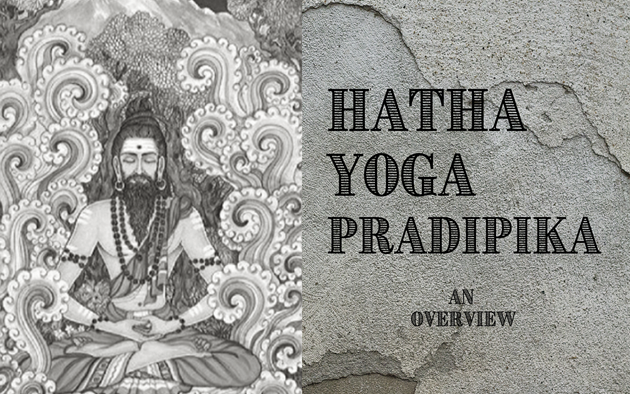Pradipika means a bright light. Hathayogapradipika means a bright light on Hathayoga. Among the various treatises Hathayoga - Hathayogapradipika by Svatmarama is respected, accepted and studied widely for its compact and the same time comprehensive approach to all aspects of Hathayoga. A popular Sanskrit commentary that throws light on subtle aspects of Hathayogapradipika is Jyotsna commentary by Brahmananda (19th Cent CE).
The author of Hathayogapradipika is variously called as Svatmarama or cintamaai or atmarama. He is known to be the Son of sahajananda yogindra.
There are four chapters in the text - Hathayogapradipika. There are about 389 verses in the entire treatise. The chapters and the distribution of the verses are as follows -
- Asana and other prerequisites for Yoga - 67
- Pranayama - 78
- Mudras - 130
- Samadhi- Nadanusandhana - 114
As can be seen above the four chapters indicated the four limbs of the Hathayoga - namely Asana, Pranayama, Mudras and Nadanusandhana. It is to be noted that the first three are the means that facilitate the practice of the last limb - Samadhi - that is also termed as Rajayoga in this treatise. There too, the practice of Nadanusandhana has been preferred in this text towards attainment of Samadhi.
Chapter - 1
The first chapter of Hathayogapradipika can be seen in the three parts -
- Part 1 - 1-16 = 16 Verses - invocation, prerequisites for Yoga
- Part 2 - 17-54 = 38 Verses - Asanas - definitions and benefits (15)
- Part 3 - 55-67= 13 Verses - dietary and other lifestyle prescriptions
Fifteen asanas are presented herein. The asanas and the respective verse numbers in which they are enumerated are given below -
- Svastikasana (19)
- Gomukhasana (20)
- Virasana (21)
- Kurmasana (22)
- Kukkutasana ( 23)
- Uttanakurmakasana (24)
- Dhanurasana (25)
- Matsyendrasana (26,27)
- Pascimatanasana (28,29)
- Mayurasana (Hand balance) (30,31)
- Savasana (32)
- Siddhasana - 5 Variations (35-43)
- Padmasana - 3 Variations (44-49)
- Simhasana (50-52)
- Bhadrasana (53,54)
Asanas 1-11 are presented as one set and Aanas 12-15 are presented as another set in the text. The second set is stated to be very important. (1.33) Even among the second set of Asanas - 12th Asanas - Siddhasana is glorified as the greatest among the Asanas(1.34). It is to be noted that - nomenclature and method of performing of Asanas 1-7 is given. Nomenclature method of performing and also benefits are given for Asanas 8-15. The types of Asanas given here in are - seated postures (1-9, 12-15), Asanas that are Commenced from a kneeling position (10) and Lying postures (11). It is also to be noted that, five variations of Siddhasana and three variations of Padamasana can be seen from the text and commentary.
Chapter - 2
The contents of the second chapter can be seen in five parts. They are as follows -
- Need of pranayama - verses 1-3
- Nadisodhana - verses 4-20
- Satkarmas (neti, vasti, dhauti, nauli, kapalabhati, trataka) and Gajakarani - verses 21- 38
- Importance of Pranayama and Ashtakumbhakas - verses 39-70
- Classification of Pranayama and Indicators of Success in hatha - verses 71-78
The eight Pranayama practices that are called as Ashtakumbhakas, which are core to this chapter, are stated, with their nomenclature, technique of practice and benefits (44- 70). This can be called as the core part of this chapter[1]. The eight Kumbhaka practices are -
- Suryabhedana,
- Ujjayi,
- Sitkari,
- Sitali,
- Bhastrika,
- Bhramari,
- Murcha,
- Plavini
Chapter - 3
The chapter can be seen in two divisions -
1) About awakening of Kundalini - verses 1-5
2) Ten Mudras - verses 6-130 (the list, details and benefits)
The Ten Mudras are enlisted and elaborated with their benefits in this section. The ten Mudras are prescribed for the awakening of the Kundalini. When Kundalini awakens, the path of Susumna that it was blocking thus far is unblocked. This facilitates the flow of Prana into Susumna. It is also stated that these practices are directly given by Adinatha and are to be protected secretly (6-9). The ten Mudras that are elaborated systematically in the treatise are
- Mahamudra (10-18)
- Mahabandha (19-25)
- Mahavedha (26- 31)
- Khecari (32-54)
- Udyana-bandha (55-60)
- Mulabandha (61-69)
- Jalandharabandha (70-76)
- Viparita-karani (77-82)
- Vajorli/Sahajoil/Amaroli (83-103)
- Sakticalana (104-126)
Chapter - 4
The fourth chapter can be seen in four divisions. They are as follows -
- Samadhi - 1 - 33
- Laya practices 29-64
- Nadanusandhana (NAS) Laya Yoga - verses 65 - 102
- Concluding verses and advice- verses 103-114
As can be seen, the Hathayoga practices that lead to the state of Rajayoga (Samadhi) have been stated in three prior chapters. Method to attain Rajayoga is stated in this chapter in the form of Nadanusandhana - a Laya practice.
The central portion of the chapter elaborates upon Nadanusandhana, the chief and best among the laya practices. This is a Manolaya practice (a state where the mind gets absorbed into the object of meditation). It is stated, that even those aspirants who cannot attain philosophical clarity intellectually (asakyatattvabodha), can practice Nadanusandhana. (65-67). Two types of Nadanusandhana practices are presented in this text. The first type is in four stages Arambha (commence), Ghata (consolidate), Paricaya (intro to higher stages), Nishpatti (reaching the goal). Here a Yogin is expected to sit in Muktasana assuming the Sambhavimudra and start focusing on the Nada manifesting in the right ear with a focused mind. As the mind is focused, the Yogin experiences the aforementioned four stages where sounds of varying nature is heard at four various beginning from Anahatacakra to Brahmarandhra.(68-81).
The second type of Nadanusandhana, according to Jyotnsa commentary is stated through the principle of Pratyahara - implying moving from grosser sounds to subtler and refined sounds. Three stages of focusing on Nadas are presented. No specific place of focus is mentioned. The three stages are -
a) Ocean, cloud, kettle drum - Initially,
b) Then - conch, bell and horn
c) And finally, Flute, vina and buzzing sound of the bees.(82- 89).
The next set of verses speak about how the mind is captivated by this practice of Nadanusandhana using examples from the nature like - bee, elephant, deer, horse and serpent. Finally it is stated that as the fire gets extinguished when the fuel is exhausted, similarly the mind that is captivated in Nada gets dissolved when Nada dies down by Paravairagya (90-102)
This in short is the overview of Hathayogapradipika which is an integral part of Yoga teaching and learning in contemporary times.
References
- Raja, Kunjunni,k, Ed. (2000), Reprint, Hathayogapradipika of svatmarama with commentary Jyotsna of Brahmananda and English Translation, The Adyar Library and Research Centre, Chennai
- Larson, Gerald James & Bhattacharya, Ramshankar, Encyclopedia of Indian Philosophies, Volume XII, Yoga: India's Philosophy of Meditation, Motilal Banarsidas Publishers Private Limited, Delhi, Reprint 2016.
- https://kymyogavaisharadi.org/ A searchable web repository of Classical Yoga Literature (includes Hathayogapradipika and jyotsna commentary)
- Jayaraman Mahadevan, (2018) Nadanusandhana - An overview of a Hathayogic Practice, , Darsanam Journal, pp.23-28
[1] In the Jyotsna Commentary to Verse 48, the ideal/beneficial daily routine for the practitioner of Hatha is described.





